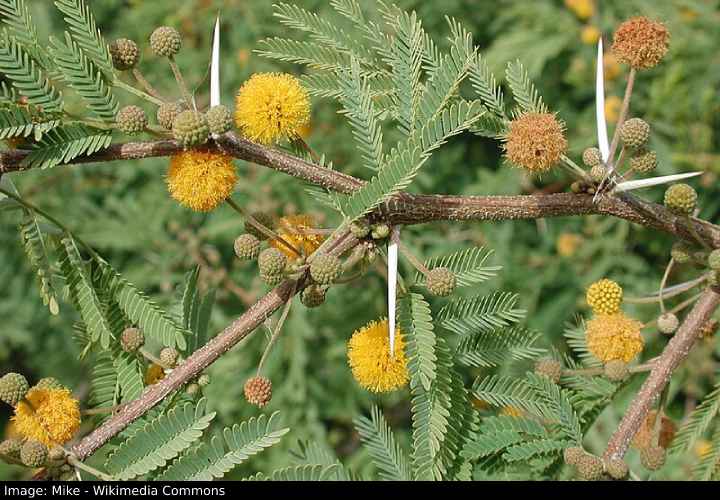Types of Trees With Thorns (Pictures and Names) – Identification Guide
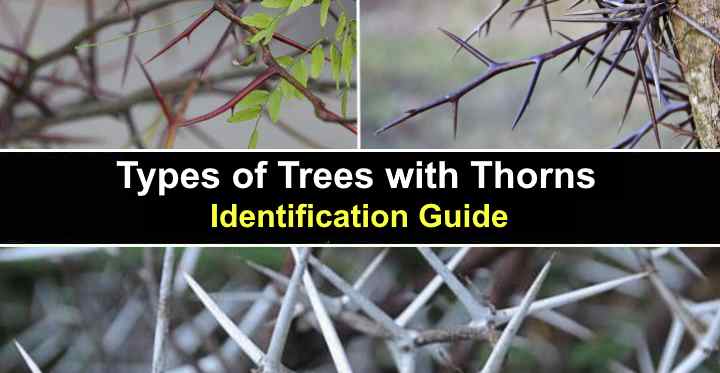
Thorny trees are characterized by having large, pointed spikes or barbs growing on their trunks or stems. Trees with thorns can be dangerous because the sharp spikes can cause injury if you brush against them. Additionally, the thorns on some trees may be hidden under leaves or hard to spot, growing in the joints of branches and twigs.
Some of the most well-known trees with thorns are the locust tree, acacia tree, hawthorn tree, and floss silk tree. Thorny trees, like the locust tree, have clusters of sharp spikes on their trunks. However, the silk floss tree has jagged protrusions all the way up its straight trunk. But the spiky hawthorn has thin branches with sparsely growing needle-like thorns.
Trees with thorns come in all shapes and sizes. And it’s good to know how to identify prickly trees without getting too close. This is because the sharp piercing barbs can puncture footwear and cause injury.
This article is a guide to identifying the most common thorny trees in a landscape. Pictures and descriptions of the trees’ spiky growths and other characteristics will help you recognize these thorny plants.
What Are Trees With Thorns?
Thorny trees are species of tall plants with prickly bark, stems, or branches. The barbs can grow in small clusters, giving the tree a spiky appearance. Alternatively, sharp thorns can grow singularly along slender twigs. Trees with thorns encompass a range of varieties, from the acacia with its sprawling crown to the small, shrub-like hawthorn tree.
Many people may refer to trees and bushes as thorny plants if they have spiny, jagged leaves. For example, the holly tree and Oregon grape holly shrub have prickly, leathery leaves. However, this article only refers to trees that have spikes, thorns, or barbs growing on bark or twigs.
Related reading: Thorny bushes for your garden.
Thorns vs. spines vs. prickles
The terms thorns, spines, and prickles are often used interchangeably. However, there are slight differences among these jagged growths. Thorns are modified shoots, as seen on a honey locust or hawthorn tree. Prickles are spikes attached to the plant’s bark, similar to those on a rose bush. Spines, on the other hand, grow from leaf tissues, much like the ones found on a holly or barberry shrub.
How to Handle Thorny Trees
Maintaining thorny trees in a garden landscape can be challenging. Care is necessary when pruning trees and when walking near the prickly specimens. Therefore, you should wear appropriate footwear that protects against slipping. Also, put on heavy-duty gloves and safety goggles to stay safe from getting jagged or puncturing your skin.
How to Identify Trees With Thorns
Identifying trees with thorns involves observing the growth characteristics of the spiky tree. You should look at the shape of the crown, its height, leaf shape, and flowers. Up close, you can identify the tree by how the thorny, spiky protrusions grow and their length.
Trees With Thorns (With Pictures) — Identification Guide
Let’s look in detail at 14 species of thorny trees that you may find in a landscape.
Acacia Tree (Acacia)

Acacia trees and shrubs can be of varying sizes and are tolerant of dry, arid conditions
Many species of acacia trees have sharp thorns covering their branches. The acacia tree is typically recognized by its flat-topped, spreading crown, foliage consisting of pinnate leaves with small oval leaflets and small flowers. Typically, acacia trees growing in arid regions develop clusters of sharp spikes on their branches.
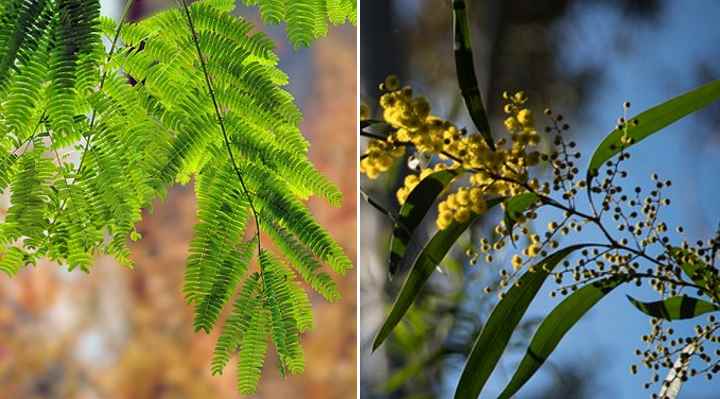
Acacia leaves can be fern-like bipinnate (left) or flattened petioles that act like leaves (right)
Acacia trees typically grow between 13 to 20 ft. (4 – 6 m) tall with an umbrella-shaped canopy measuring 26 ft. (8 m) in diameter. However, some varieties can grow taller, reaching up to 65 ft. (20 m) or even more. Acacia trees are well suited to growing in the desert because they tolerate drought and hot sunshine.
Other names for acacia trees include thorntree, mimosa, or wattle tree.
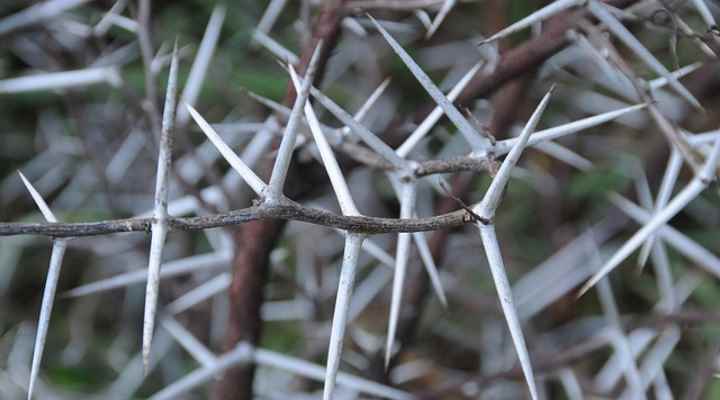
A close up picture of Acacia thorns
Thorny tree identification
Acacia trees are identified by their grayish-white sharp spikes growing in pairs on reddish-brown branches. Also, acacia trees have easily identifiable leaves that resemble those on a mimosa plant.
Mature Size: 13 to 65 ft. (4 – 20 m), with some reaching even higher (depending on cultivar)
USDA Hardiness Zones: 7 to 11 (depending on cultivar)
Sun: Full sun
Honey Locust Tree (Gleditsia triacanthos)
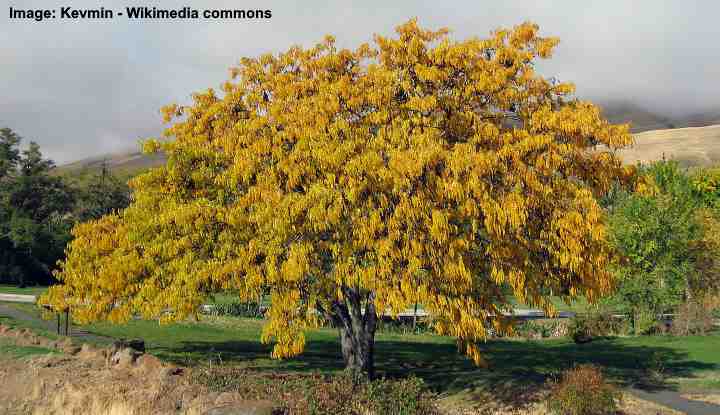
Honey locust tree
The honey locust tree is a large, fast-growing deciduous tree with a trunk covered in large, sharp branched spikes. The menacing locust tree thorns can only be described as vicious. Other identifying features of locust trees are their pinnately compound leaves, long reddish-brown seed pods, and small clusters of greenish-yellow flowers.

honey locust leaves and flowers
The honey locust tree grows 60 to 80 ft. (18 – 24 m) tall and wide. The extremely sharp thorny spikes grow up to 3” (7.5 cm) long. It also has easily recognizable mimosa-like feathery leaves consisting of tiny oval leaflets. In the fall, honey locust trees turn golden yellow before dropping their leaves.
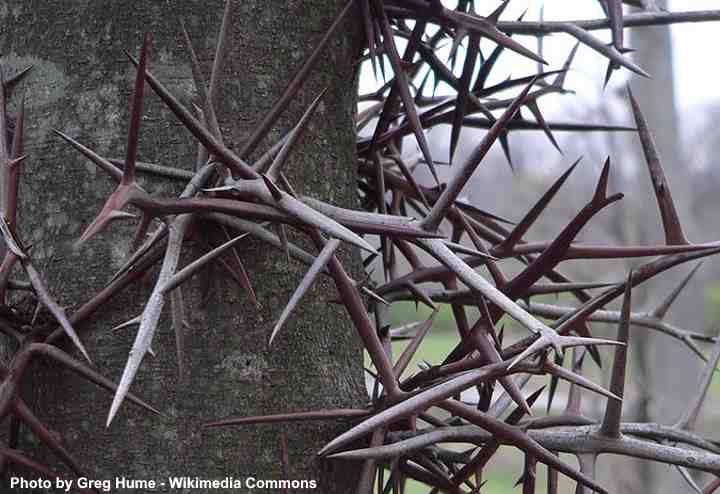
Honey locust bark and thorns
Honey locust trees are not suitable for residential landscapes. However, thornless cultivars like Gleditsia triacanthos var. inermis aren’t as dangerous as the specimen tree.
Thorny tree identification
The thorn-laden honey locust tree is identified by its stout, needle-sharp thorns, with some reaching over 8” (20 cm) long. The pinnately compound leaves are bright green in summer and yellow in the fall.
Mature Size: 60 to 80 ft. (18 – 24 m) tall and wide
USDA Hardiness Zones: 4 to 8
Sun: Full sun
Black Locust (False Acacia) Tree (Robinia pseudoacacia)
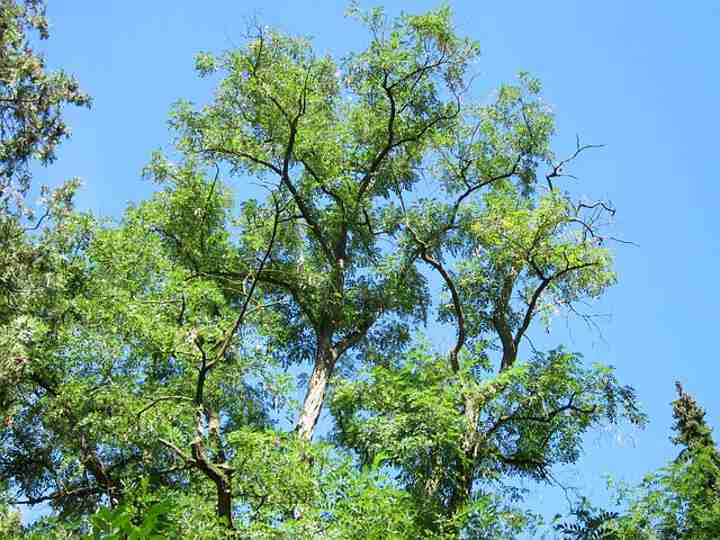
Black locust tree
The black locust is a medium-sized deciduous tree with small sharp thorns growing along its branches. The shrub-like tree tends to be weedy and vigorously produces suckers. The black locust has pinnately compound leaves, dangling clusters of white pea-like flowers, and reddish-brown flattened seed pods.
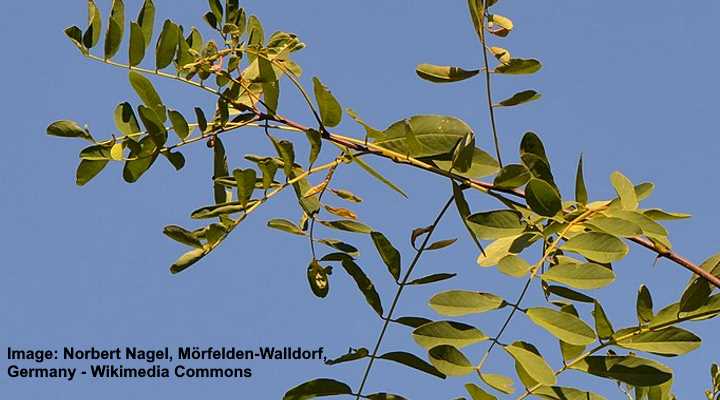
Black locust leaves and thorny branches
Black locust trees grow 30 to 50 ft. (9 – 15 m) tall and up to 35 ft. (10.5 m) wide. The pinnately compound leaves grow 8” to 14” (20 – 35 cm) long, each containing 7 to 21 leaflets. The showy, fragrant wisteria-like white flower clusters measure 8” (20 cm) long and develop into long seed pods.
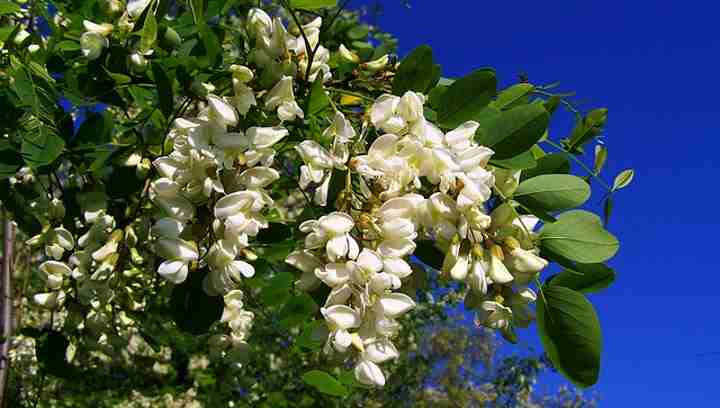
Black locust tree flowers
Black locust trees thrive in USDA zones 3 to 9 and require full sun or partial shade and well-drained soil.
Thorny tree identification
The identifying features of a black locust tree are its thorny brittle branches, dark brown to black furrowed bark, and fragrant white flowers.
Mature Size: 30 to 50 ft. (9 – 15 m) tall and up to 35 ft. (10.5 m) wide
USDA Hardiness Zones: 3 to 9
Sun: Full sun to partial shade
Hawthorn Tree (Crataegus)
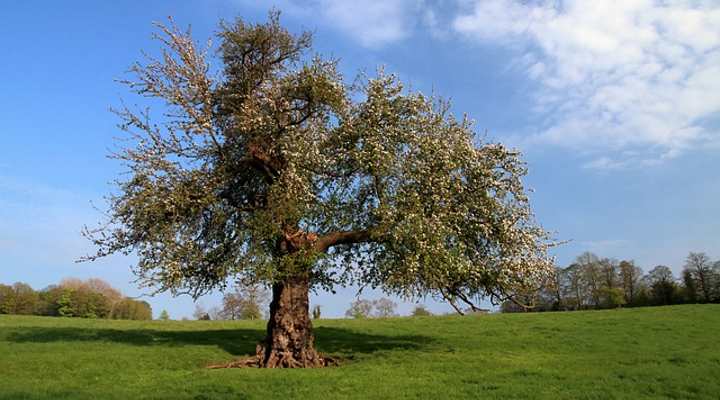
Hawthorn tree
Hawthorn trees have sharp-tipped thorns growing on the bark or branches. The sharp thorns can be multi-branched, making them even more dangerous. Leaves on hawthorn trees are small oval leaves with deep lobbing, giving them the appearance of parsley leaves. The trees and shrubs have large clusters of creamy-white flowers.
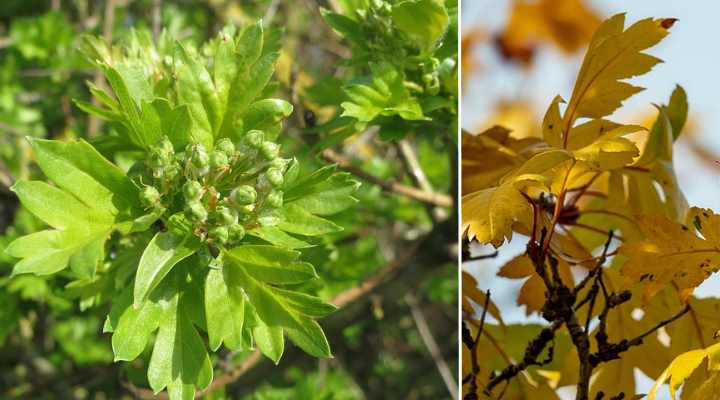
Hawthorn leaves and autumn foliage (right)
Species of hawthorn are either large thorny shrubs or small trees with spikes. The prickly trees grow 15 – 50 ft. (5 – 15 m) tall. Usually, the stiff thorns typically grow between 1” and 3” (2.5 – 7.5 cm) long, and the flat-topped scented flower clusters cover the tree in late May or early June.
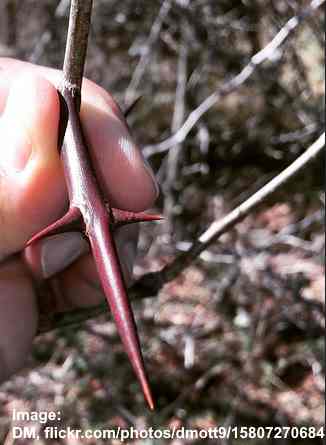
Hawthorn thorns
Another attractive feature of ornamental hawthorn trees is their beautiful leaves, which emerge reddish-purple in spring and turn green in summer before changing to bright red, purple, or orange in the fall.

Hawthorn flowers
Thorny tree identification
A hawthorn tree is recognized by its rounded, spreading crown, masses of white spring flowers, and red berry-like drupes in the fall. In addition, hawthorn tree branches have characteristic spiky thorns measuring around 1” (2.5 cm) or longer.
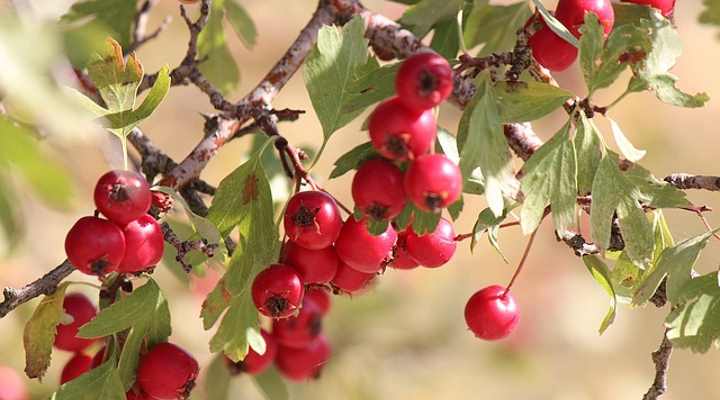
Hawthorn berries
Mature Size: 15 – 50 ft. (5 – 15 m)
USDA Hardiness Zones: 2 to 9 (depending on cultivar)
Sun: Full sun
Mesquite Tree (Prosopis)
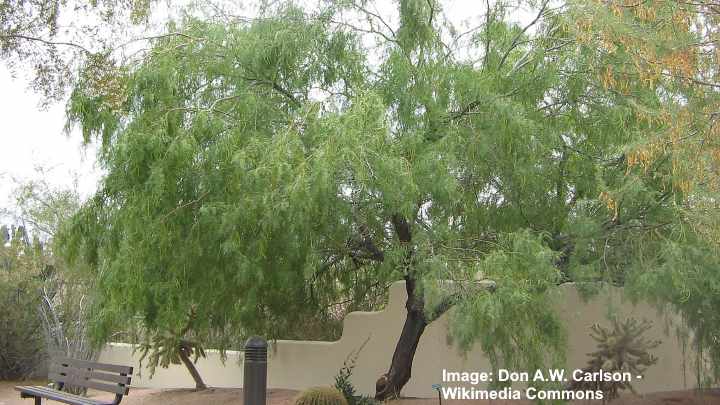
Honey mesquite tree (Prosopis glandulosa)
Mesquite trees are small, multi-stemmed trees, and several varieties grow stiff, sharp thorns on the branches. The nail-like spikes can grow around 3” (7.5 cm) long and easily puncture the skin. Mesquite flowers are fuzzy spikes of yellowish flowers that bloom in spring and summer, followed by dangling bean pods.
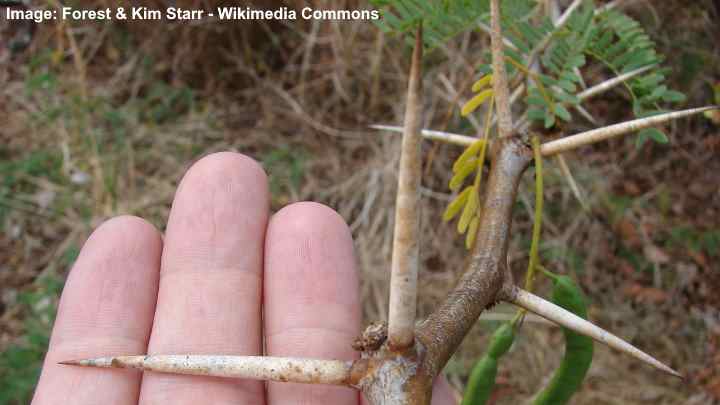
Mesquite thorns – in the picture the thorns are of Prosopis juliflora
Mesquite trees grow up to 26 ft. (8 m) tall and wide. These trees are known for their crooked branches, feathery pinnately compound leaves, and stout thorns, which usually grow in pairs.

The leaves of the mesquite tree are compound pinnate
Mesquite trees adapt well to growing in the desert. The small shrub-like trees have deep taproots, and the foliage is highly tolerant of heat. You can also grow a mesquite tree in a residential landscape as a shade tree for dappled shade or a lawn tree. And it’s possible to buy thornless varieties.
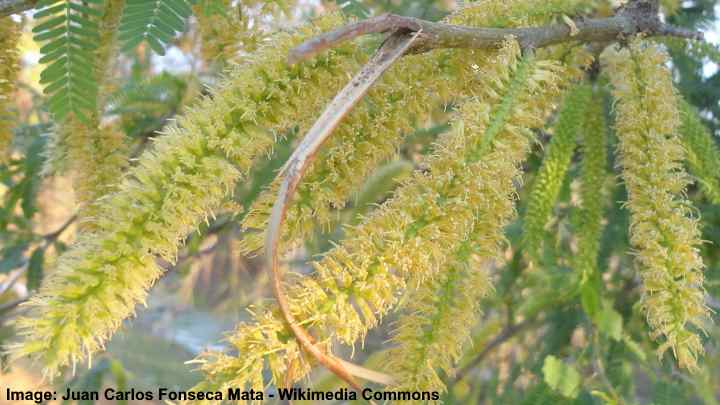
Mesquite flowers – picture of smooth mesquite (Prosopis laevigata) flowers
Thorny tree identification
Mesquite trees are identified by their yellowish-brown sharp thorns, slender bipinnately compound leaves, and yellow flowering spikes.
Mature Size: 26 ft. (8 m) tall and wide
USDA Hardiness Zones: 6 to 10
Sun: Full sun
Palo Verde Tree (Parkinsonia)

Foothills palo verde (Parkinsonia aculeata) tree
The palo verde tree is a small prickly tropical tree characterized by its upright, thorny branches. Apart from their reddish thorns on green branches, palo verde trees are recognized by their yellow and orange showy flowers that cover the trees through warm weather in USDA zones 8 to 11.
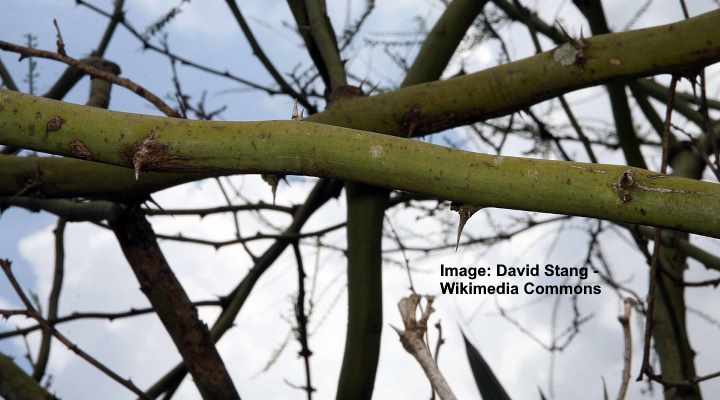
Palo verde (Parkinsonia aculeata) thorns
Palo verde trees grow 16 to 40 ft. (5 – 12 m) tall and have an upright branching habit and vase shape. The heat-loving yellow-flowering trees bloom after rain but lose their bipinnately compound leaves during dry summers. Small palo verde shrubs grow as dense thickets.
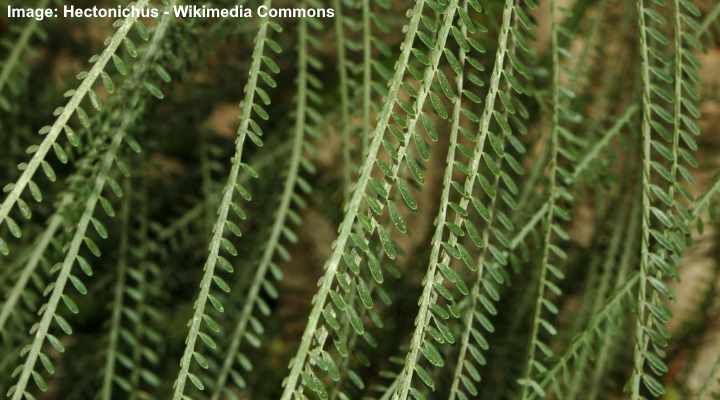
Palo verde (Parkinsonia aculeata) leaves
Thorny tree identification
Identifying features of the palo verde tree are its yellow flowers with orange patches, long 5-inch (12 cm) bean pods, and sharp barbs growing along its branches.

Palo verde (Parkinsonia aculeata) flowers
Mature Size: 16 to 40 ft. (5 – 12 m)
USDA Hardiness Zones: 8 to 11
Sun: Full sun
Floss Silk Tree (Ceiba speciosa)
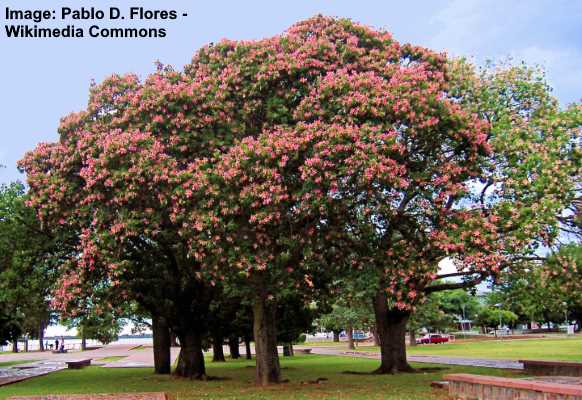
Floss silk tree (Ceiba speciosa)
The floss silk tree is an unusual tropical tree that develops spiky conical prickles on its erect trunk, giving it an armored appearance. The tree’s horizontal branches (also covered in prickles) grow to form an attractive rounded canopy. Dark green, dense foliage covers the tree, contrasting with the showy pink hibiscus-like flowers.

Floss silk flowers and leaves
The floss silk tree grows up to 82 ft. (25 m) and has a bottle-shaped trunk that bulges near the base. The pink flowers, with their creamy-white and yellow centers, measure 4” to 6” (10 – 15 cm) in diameter and have five slender petals in a star shape.
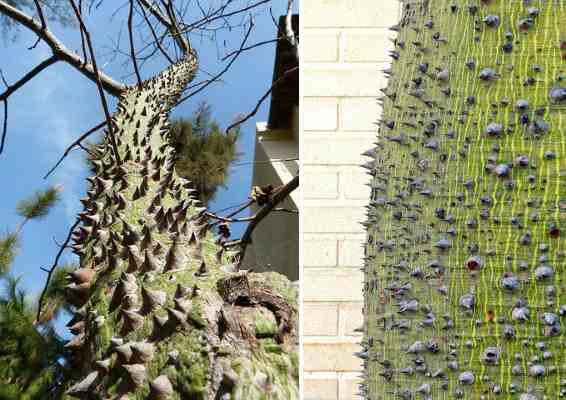
Floss silk trunk
Thorny tree identification
The floss silk tree is easily identified due to its grayish conical prickles covering the cylindrical green trunk.
Mature Size: 82 ft. (25 m)
USDA Hardiness Zones: 9 to 11
Sun: Full sun
Sandbox Tree (Hura crepitans)
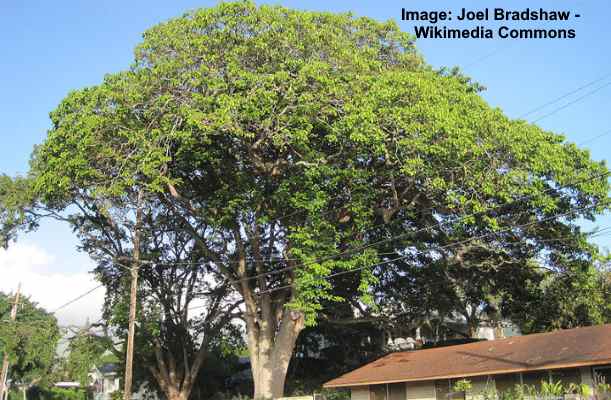
The sandbox tree is an evergreen tree with a thorny trunk
The sandbox tree is identified by its smooth brown bark covered in extremely sharp, pyramid-shaped pointed prickles. This tropical tree has several unusual growth features. The sandbox tree produces small red petal-less flowers, large ovate leaves up to 2 ft. (0.6 m) wide, and small roundish pumpkin-like fruits that explode when ripe.
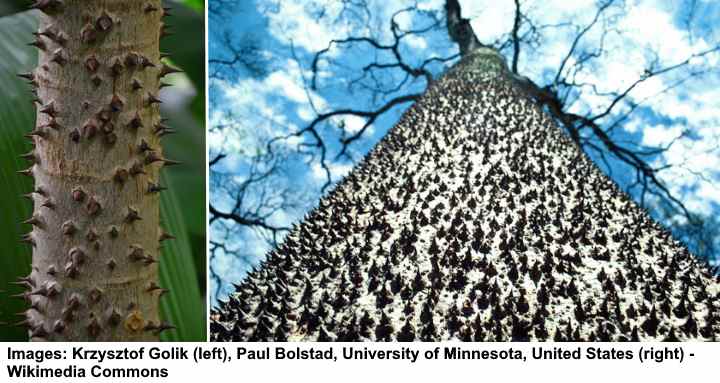
Sandbox tree trunk
The vast sandbox tree grows 200 ft. (60 m) tall and thrives in wet soils in USDA zones 10 and 11.
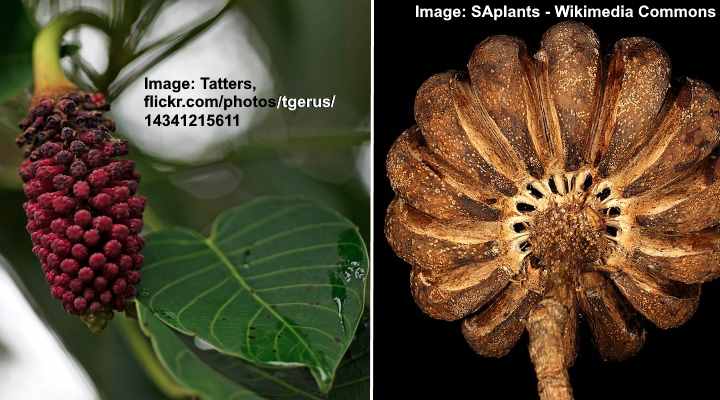
Sandbox tree male flowers, leaf and seed
Thorny tree identification
The sandbox tree is easily identifiable due to its sharp, prickly protrusions on its trunk, enormous size, and exploding fruit.
Mature Size: 200 ft. (60 m)
USDA Hardiness Zones: 10 to 11
Sun: Full sun
Devil’s Walking Stick (Aralia spinosa)
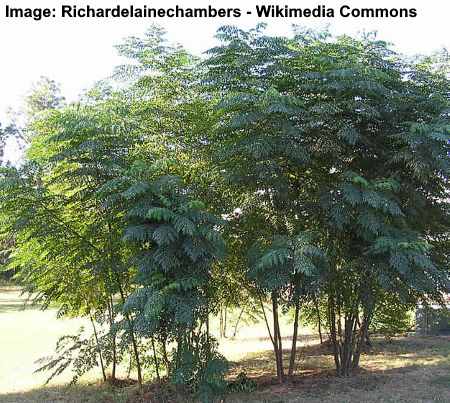
Devil’s walking stick trees
The devil’s walking stick tree is a small deciduous tree with slender stems covered in curved, fiercely sharp brown to tan spines. The tropical-looking spiny tree has large leaves measuring up to 45” (120 cm) long and a rounded, umbrella-shaped crown. The tree blooms in late summer with small, creamy-white flowers that develop into purplish-black berries.
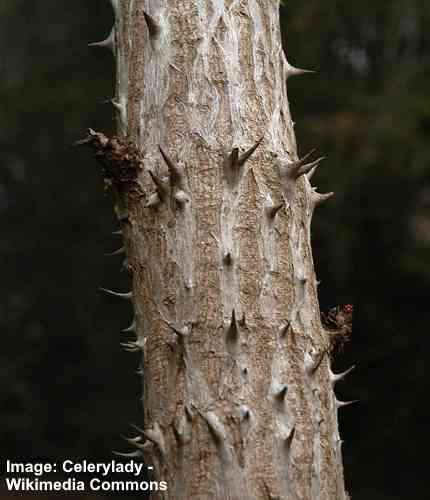
Aralia spinosa thorny stem
With its spiny stems, the devil’s walking stick grows up to 26 ft. (8 m) tall. Its unique features are huge tropical leaves and stems with stout, sharp spines. Additionally, the tree has creamy-white flowers blooming late in summer, followed by black fleshy fruits.
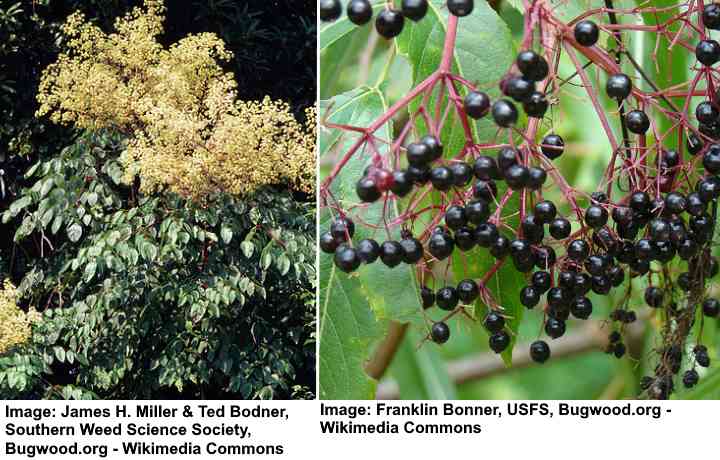
Aralia spinosa flowers, leaves and fruit
Thorny tree identification
The devil’s walking stick is identified by its upright stems with ferociously sharp spines, large tropical leaves, and clusters of feathery creamy-white flowers.
Mature Size: Up to 26 ft. (8 m)
USDA Hardiness Zones: 5 to 9
Sun: Full sun to partial shade
Kapok (Ceiba pentandra)

Kapok tree (Ceiba pentandra)
Kapok is a species of large tree with sharp thorns growing extensively on its bark. Kapok trees are identified by their thorny buttress roots, large palmate leaves, and clusters of tiny yellowish-white flowers. The unique characteristic of the tree is its cotton-like downy substance surrounding the seed pods.
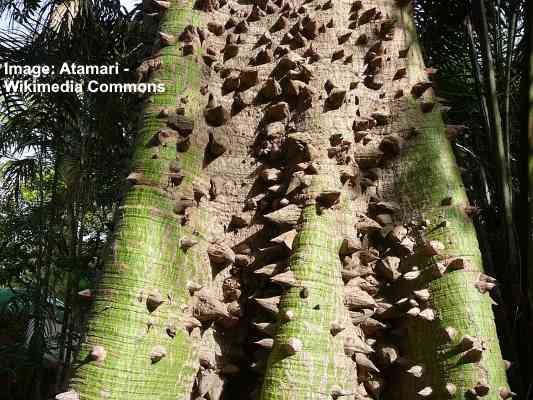
Kapok thorny buttress roots and trunk base
Kapok trees are giant tropical trees that thrive in USDA zones 10 to 12. The thorny trees can grow 75 to 125 ft. (22 – 38 m) tall and up to 75 ft. (22 m) wide.
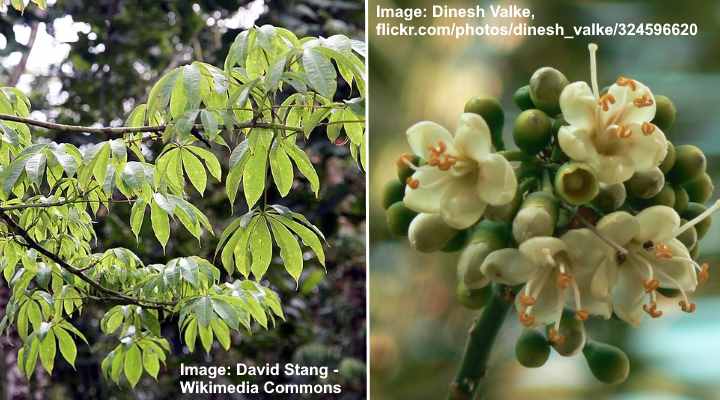
Kapok leaves and flowers
Thorny tree identification
The thorny kapok tree is identified by its straight trunk covered in stout, sharp thorns, palmate compound leaves, and creamy-white flower clusters consisting of bell-shaped flowers.
Mature Size: 75 to 125 ft. (22 – 38 m)
USDA Hardiness Zones: 10 to 12
Sun: Full sun
Chittamwood Tree (Sideroxylon lanuginosum)
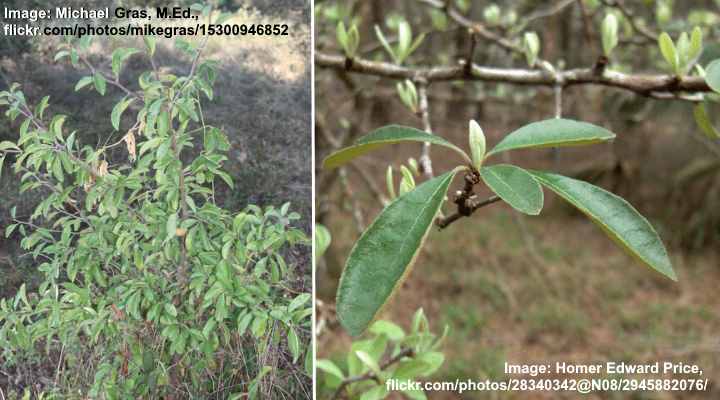
Chittamwood tree leaves
Chittamwood tree is a small, shrub-like tree with thorny branches. Identifying characteristics of the deciduous tree are its spiny, stiff, woolly branches, oblong green leaves with fuzzy undersides, and clusters of purplish-black fruits. The multi-stemmed spiny tree grows up to 40 ft. (12 m) tall and has a straight trunk and rounded, narrow crown.
Common names for Sideroxylon lanuginosum describe many of its growth habits. For example, woolly buckthorn, gum bumelia, and gum bully refer to its fuzzy leaves and sticky gum-like substance the tree produces.
Thorny tree identification
The chittamwood tree is identified by its straight trunk with dark bark, stiff branches, sharp spines, and oblong oval leaves.
Mature Size: Up to 40 ft. (12 m)
USDA Hardiness Zones: 6 to 10
Sun: Full sun to partial shade
Osage Orange (Maclura pomifera)
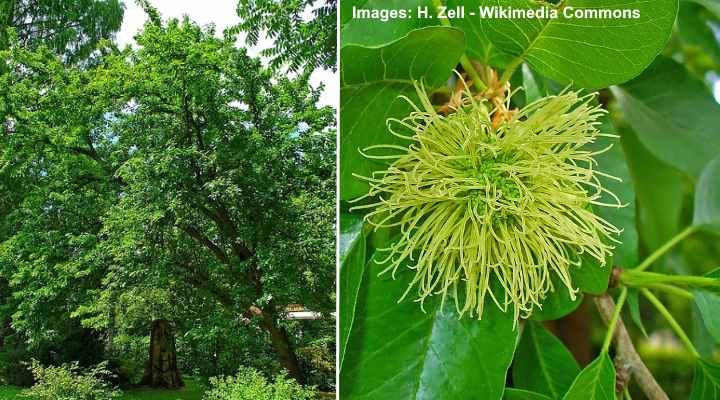
Osage orange mature tree and flower
The osage orange tree is a mid-sized, multi-stemmed tree with stout, sharp thorns on its interlacing branches. This thorny deciduous tree has a rounded crown of shiny, dark green leaves and small greenish spring flowers. The unique feature of this thorny tree is its large grapefruit-like round yellowish-green fruits.
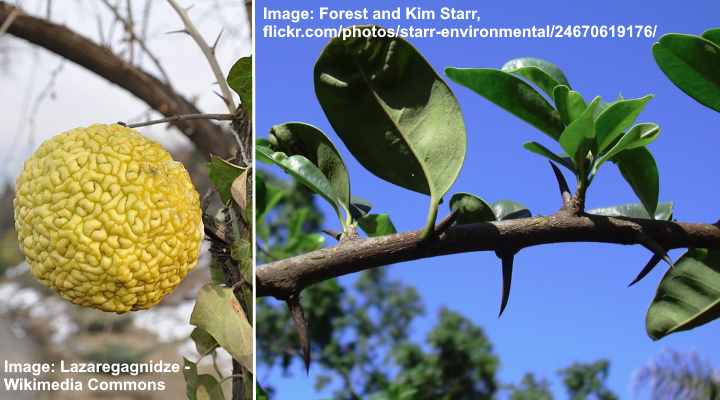
Osage orange fruit, leaves and thorny branches
Osage orange trees grow 25 to 60 ft. (7.5 – 18 m) tall. Its unusual round, inedible fruits are about the size of a baseball. Due to the nasty thorns on the small shrub-like tree, the plant can be used as a security hedge or living fence.
It thrives in USDA zones 4 to 9.
Thorny tree identification
Osage orange is identified by its thorny branches, large orange-like fruit, and rounded crown.
Mature Size: 25 to 60 ft. (7.5 – 18 m)
USDA Hardiness Zones: 4 to 9
Sun: Full sun to partial shade
Pejibaye (Peach) Palm (Bactris gasipaes)
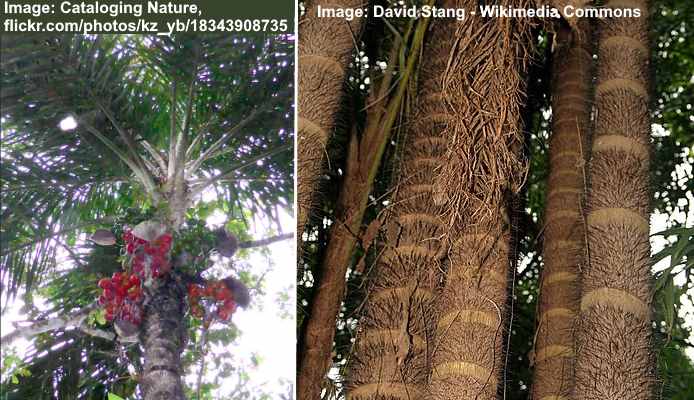
Pejibaye (Peach) palm tree with fruit (left) and thorny trunks (right)
Peach palm trees are an unusual species of palm due to the sharp black spines covering their trunk. These palm trees have the characteristic slender palm trunk and rounded crown, large arching pinnate leaves growing 10 ft. (3 m) long, and reddish, orange, or yellow palm fruits. Spiny pejibaye palms grow 66 ft. (20 m) tall.
An unusual feature of peach palm trees is their clusters of cylindrical yellow inflorescences. These develop into large bunches of edible egg-shaped fruits 2.3” (6 cm) long that are known for their nutty flavor.
Thorny tree identification
Pejibaye palm trees are easy to identify due to their tall, slender trunks densely covered in black spines measuring 2” (5 cm) long.
Mature Size: Up to 66 ft. (20 m)
USDA Hardiness Zones: 10 to 11
Sun: Full sun
Pochote (Pachira quinata)
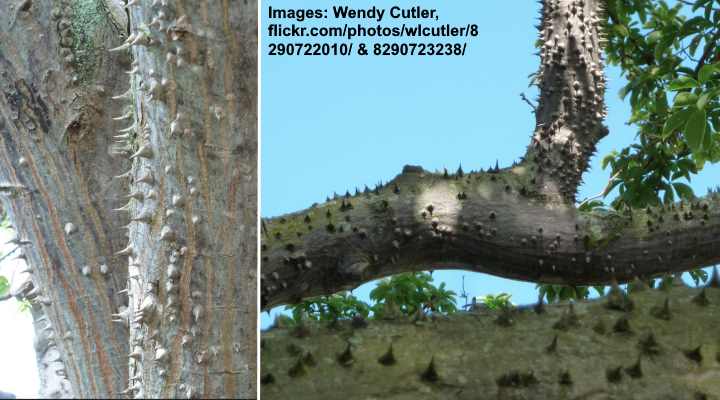
Pochote thorny trunks and branches
Pochote is a species of flowering tree characterized by masses of sharp, stubby thorns covering its branches and trunk. The spiny tree is identified by its palmate leaves with five obovate leaflets, flowering with slender, wiry petals, and fruits containing seeds covered in cotton-like hairs. Thorny pochote trees grow 20 to 103 ft. (6 – 31 m) tall.
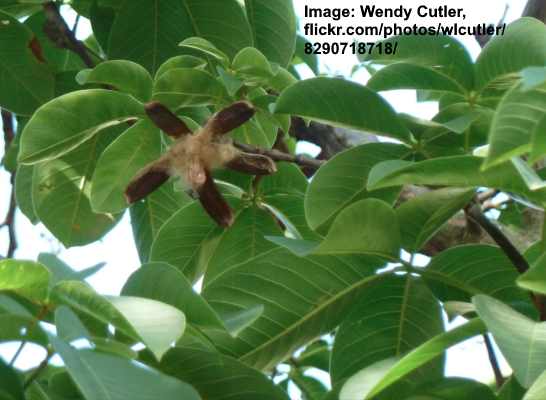
Pochote leaves and seeds
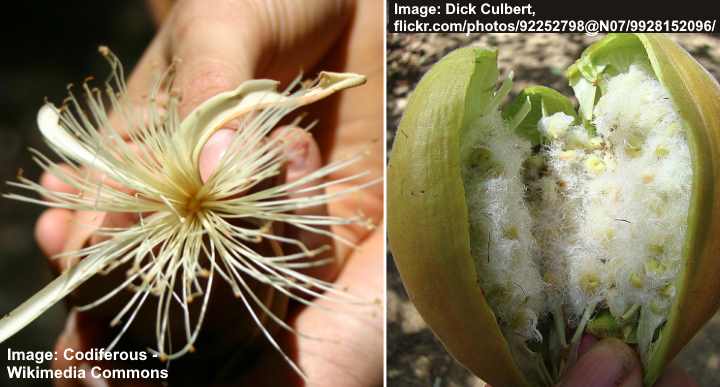
Pochote flower and fruit
Mature Size: 20 to 103 ft. (6 – 31 m)
Sun: Part sun
European Crabapple (Malus sylvestris)

The European crabapple is a deciduous tree with red-brown, slender twigs and branches that are frequently covered in large, sharp thorns. Some other identifying features include glossy, alternate, oval-shaped leaves with serrated edges, a bush-like appearance, and small, green, apple-like fruits with red spots.
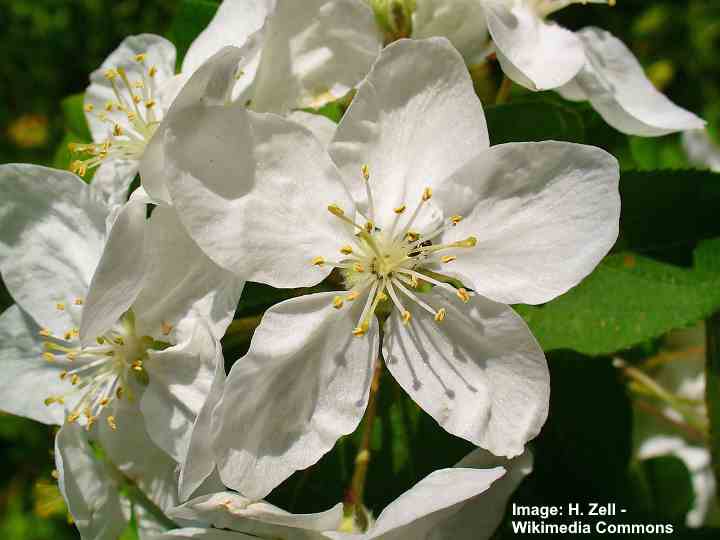
The European crabapple also produces fragrant, five-petaled, pale-pink to white flowers. The flowers are rich in nectar, attracting various pollinators such as bees and butterflies. For optimal growth, plant this tree in organically fertile, well-drained, moist soil.
Thorny tree identification
The European crabapple is identified by its rounded canopy shape and upright branches and stems covered with sharp spines.
Mature Size: Up to 33 ft. (10 m) tall
USDA Hardiness Zones: 4 to 8
Sun: Full sun to partial shade
Sweet Acacia (Vachellia farnesiana)
The sweet acacia is a small, yellow-flowering, deciduous tree with sharp, needle-like thorns on its trunk and branches. The leaves are medium-green, feathery, and bippinate, with the base being coupled by a pair of thorns. Additionally, it produces elongated, narrow, brown seed pods.
The sweet acacia is recognized for its beautiful, pom-pom-like, yellow-golden flowers. The flowers are small and emit a delightful fragrance, drawing in pollinators such as butterflies and bees. Once established, the tree is tolerant of salty wind, salt spray, and drought. Plant in loose, dry to medium, well-drained soils.
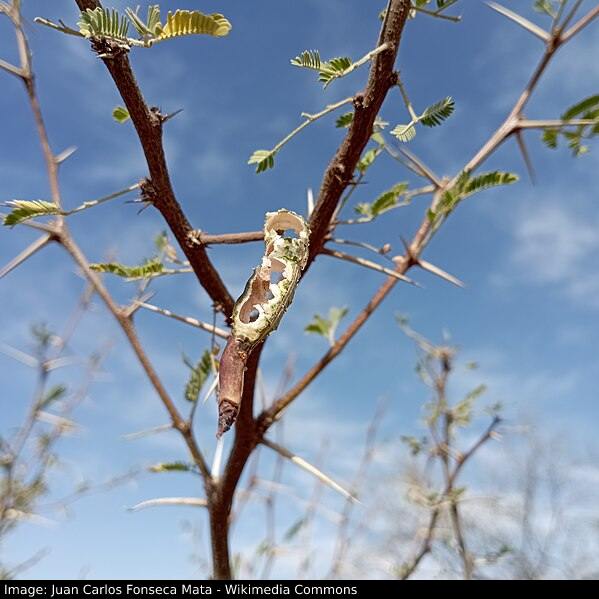
Thorny tree identification
The sweet acacia can be recognized by its yellow puffball-like flowers and long, sharp thorns found on either the trunk or its branches. The thorns are usually white in color and around 1 inch (2.5 cm) long.
Mature Size: 15 to 20 ft. (4.5 – 6 m) tall and wide
USDA Hardiness Zones: 9 to 11
Sun: Full sun to partial shade
Coast Coral Tree (Erythrina caffra)
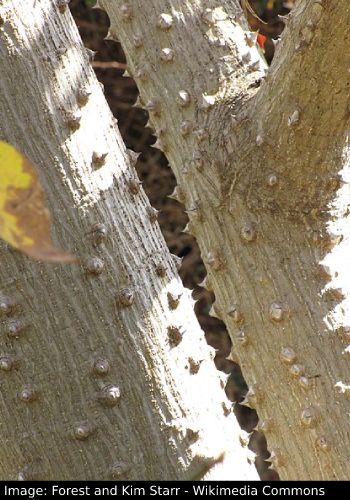
The coast coral tree is a medium-sized, deciduous tree with smooth, slightly furrowed, pale-gray bark covered with short, thick thorns. Thorns are also found on the tree’s branches, with younger trees tending to have sharper thorns. It also has a round, spreading canopy, making it an ideal shade tree.

The coast coral tree is well-known for its showy, orange-red flowers that resemble coral, giving the tree its name. The flowers attract birds, butterflies, and other pollinators. The tree also produces leathery, black seed pods containing bright red seeds. Plant in well-drained soil for optimal results.
Thorny tree identification
The coast coral tree can be identified by its coral-like, red-orange flowers and its slightly furrowed, gray trunk that is sporadically covered with thorns.
Mature Size: 30 to 40 ft. (9 – 12 m) tall and 23 to 36 ft. (7 – 11 m) wide
USDA Hardiness Zones: 9 to 11
Sun: Full sun
Catclaw Acacia (Senegalia greggii)
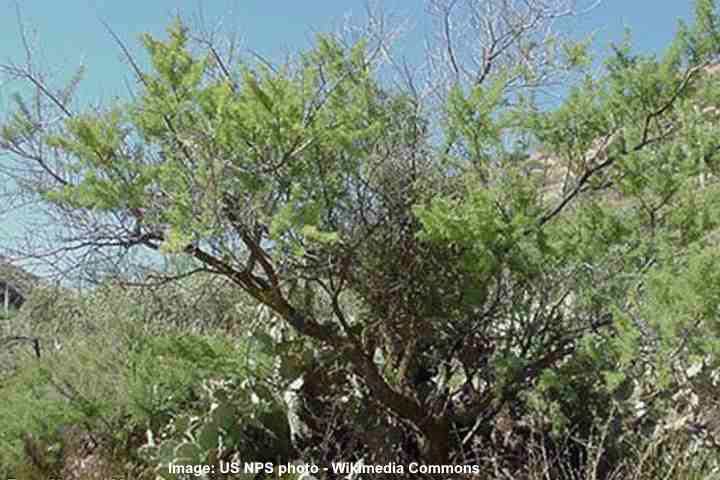
The catclaw acacia is a slow-growing shrubby tree known for its sharp thorns found on its branches. The tree’s name comes from its curved, hook-like thorns, which resemble cat claws. It also features leaves that are deciduous, bipinnately compound, and gray-green in color.

The catclaw acacia, showcases beautiful, creamy-white, fuzzy flowers in spring. Additionally, it produces flat, twisted seed pods containing brown seeds. For optimal growing, plant in well-draining, sandy or rocky soil.
Thorny tree identification
Identify the catclaw acacia by its hook-like thorns on its branches, twisted seed pods, and creamy-white fuzzy flowers.
Mature Size: About 10 ft. (3 m)
USDA Hardiness Zones: 9 to 10
Sun: Full sun
Discover many types of thorny bushes and vines (with pictures).
Related articles:
- Acacia Trees – Types and Identification
- Locust Trees – Types and Identification
- Hawthorn Trees – Types and Identification


